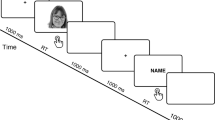Abstract
The N170 face repetition effect has been proposed to reflect early identity processing that underlies the acquisition of familiarity for novel faces. It was reported that the N170 face repetition effect was lateralized to the right hemisphere. Since it has been postulated that reduced or reversed brain asymmetry may be importantly related to schizophrenia pathology, the present study examined whether or not male patients with chronic schizophrenia show reduced or reversed asymmetry in the N170 face repetition effect. Seventeen male schizophrenia patients and 13 male healthy controls participated. Event-related potentials were recorded to unrepeated and repeated faces. Patients with schizophrenia showed a bilateral N170 reduction to repeated and unrepeated faces compared to healthy subjects (F[1,28] = 8.01, p = 0.009). Schizophrenia patients showed a significant decrease in N170 amplitude to repeated faces at the left occipitotemporal electrode (t[16] = 2.91, p = 0.01), whereas healthy subjects showed a significant decrease at the right occipitotemporal electrode (t[12] = 2.36, p = 0.04). These results suggest abnormal asymmetry of the N170 face repetition effect in schizophrenia.


Similar content being viewed by others
References
Allison, T., Puce, A., Spencer, D. D., et al. (1999). Electrophysiological studies of human face perception. I: Potentials generated in occipitotemporal cortex by face and non-face stimuli. Cerebral Cortex (New York, N.Y.), 9, 415–430. doi:10.1093/cercor/9.5.415.
American Psychiatric, Association. (1994). Diagnostic and statistical manual of mental disorders (4th ed.). Washington, DC: American Psychiatric.
Bentin, S., Allison, T., Puce, A., et al. (1996). Electrophysiological studies of face perception in humans. Journal of Cognitive Neuroscience, 8, 551–565.
Cabeza, R., & Nyberg, L. (2000). Imaging cognition II: an empirical review of 275 PET and fMRI studies. Journal of Cognitive Neuroscience, 12, 1–47. doi:10.1162/08989290051137585.
Campanella, S., Hanoteau, C., Depy, D., et al. (2000). Right N170 modulation in a face discrimination task: an account for categorical perception of familiar faces. Psychophysiology, 37, 796–806. doi:10.1017/S0048577200991728.
Crow, T. J., Ball, J., Bloom, S., et al. (1989). Schizophrenia as an anatomy of development of cerebral asymmerty. Archives of General Psychiatry, 46, 1145–1150.
Ekman, P., & Friesen, W. (1978). Facial Action Coding System. Palo Alto: Consulting Psychologists.
Harris, A., & Nakayama, K. (2007). Rapid face-selective adaptation of an early extrastriate component in MEG. Cerebral Cortex (New York, N.Y.), 17, 63–70. doi:10.1093/cercor/bhj124.
Heisz, J. J., Watter, S., & Shedden, J. M. (2006a). Progressive N170 habituation to unattended faces. Vision Research, 46, 47–56. doi:10.1016/j.visres.2005.09.028.
Heisz, J. J., Watter, S., & Shedden, J. M. (2006b). Automatic face identity encoding at the N170. Vision Research, 46, 4604–4614. doi:10.1016/j.visres.2006.09.026.
Herrmann, M. J., Ellgring, H., & Fallgatter, A. J. (2004). Early-stage face processing dysfunction in patients with schizophrenia. The American Journal of Psychiatry, 161, 915–917. doi:10.1176/appi.ajp.161.5.915.
Kircher, T. T., Rapp, A., Grodd, W., et al. (2004). Mismatch negativity responses in schizophrenia: a combined fMRI and whole-head MEG study. The American Journal of Psychiatry, 161, 294–304. doi:10.1176/appi.ajp.161.2.294.
Lennox, B. R., Park, S. B. G., Jones, P. B., et al. (1999). Spatial and temporal mapping of neural activity associated with auditory hallucinations. Lancet, 353, 644. doi:10.1016/S0140-6736(98)05923-6.
Niznikiewicz, M., Donnino, R., McCarley, R. W., et al. (2000). Abnormal angular gurus asymmetry in schizophrenia. The American Journal of Psychiatry, 157, 428–437. doi:10.1176/appi.ajp.157.3.428.
Obayashi, C., Nakashima, T., Maekawa, T., et al. (2008). Abnormal N170 modulation in frequency change in male patients with chronic schizophrenia. Biological Psychiatry, 63, 822S.
Onitsuka, T., Niznikiewicz, M. A., Spencer, K. M., et al. (2006). Functional and structural deficits in brain regions subserving face perception in schizophrenia. The American Journal of Psychiatry, 163, 455–462. doi:10.1176/appi.ajp.163.3.455.
Rapcsak, S. Z., Polster, M. R., Glisky, M. L., et al. (1996). False recognition of unfamiliar faces following right hemisphere damage: neuropsychological and anatomical observations. Cortex, 32, 593–611.
Semlitsch, H. V., Anderer, P., Schuster, P., et al. (1986). A solution for reliable and valid reduction of ocular artifacts, applied to the P300 ERP. Psychophysiology, 23, 695–703. doi:10.1111/j.1469-8986.1986.tb00696.x.
Shan-Ming, Y., Flor-Henry, P., Dayi, C., et al. (1985). Imbalance of hemispheric functions in the major psychosis: a study of handedness in the People’s Republic of China. Biological Psychiatry, 20, 906–917. doi:10.1016/0006-3223(85)90216-1.
Sommer, I., Ramsey, N., Kahn, R., et al. (2001). Handedness, language lateralization and anatomical asymmetry in schizophrenia: meta-analysis. The British Journal of Psychiatry, 178, 344–351. doi:10.1192/bjp.178.4.344.
Wada, Y., & Yamamoto, T. (2001). Selective impairment of facial recognition due to a haematoma restricted to the right fusiform and lateral occipital region. Journal of Neurology, Neurosurgery, and Psychiatry, 71, 254–257. doi:10.1136/jnnp.71.2.254.
Wechsler, D. (1981). Wechsler adult intelligence scale-revised. New York, NY: Jovanovich.
Acknowledgements
The authors gratefully acknowledge the administrative support of Marie Fairbanks and the assistance of Yoji Hirano, M.D., Ph.D., Rakibul Mannan, Ph.D., Meredith C. Klump, B.A., and Sarah M. Rabbitt, B.A.
Author information
Authors and Affiliations
Corresponding author
Rights and permissions
About this article
Cite this article
Onitsuka, T., Spencer, K.M., Lucia, L.C. et al. Abnormal Asymmetry of the Face N170 Repetition Effect in Male Patients with Chronic Schizophrenia. Brain Imaging and Behavior 3, 240–245 (2009). https://doi.org/10.1007/s11682-009-9066-3
Received:
Accepted:
Published:
Issue Date:
DOI: https://doi.org/10.1007/s11682-009-9066-3




